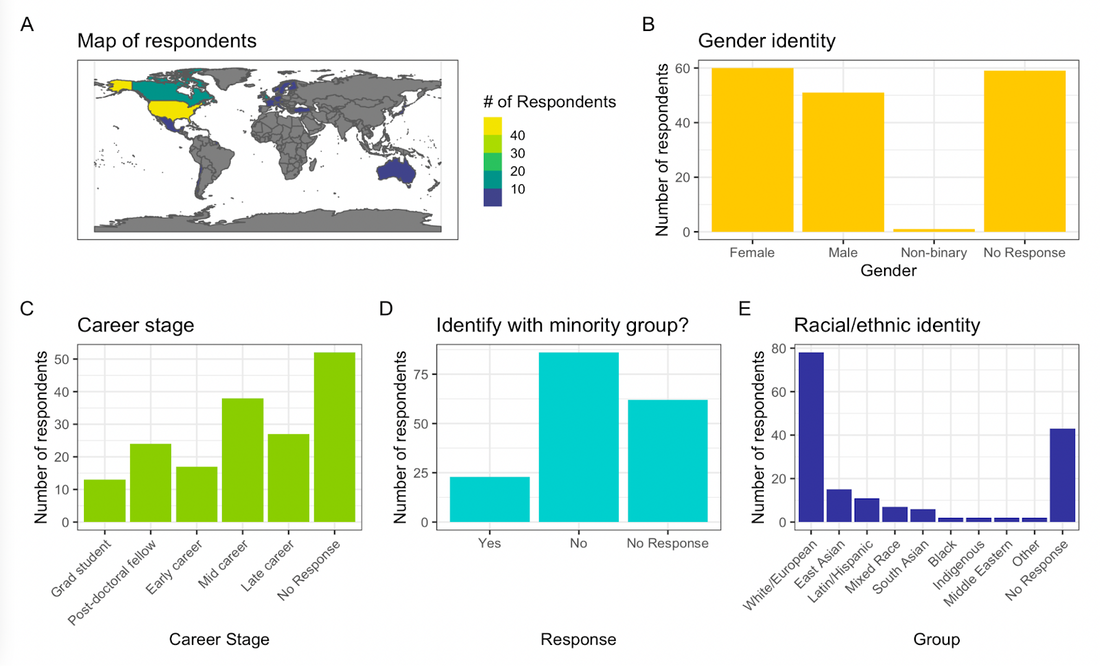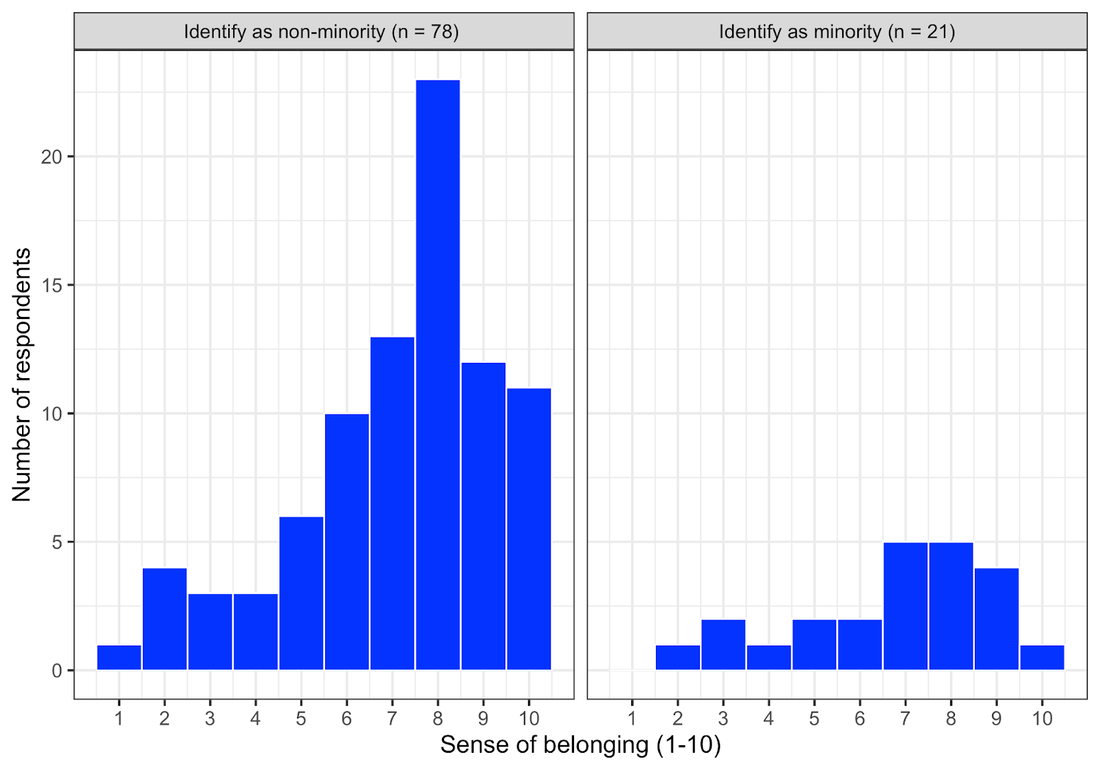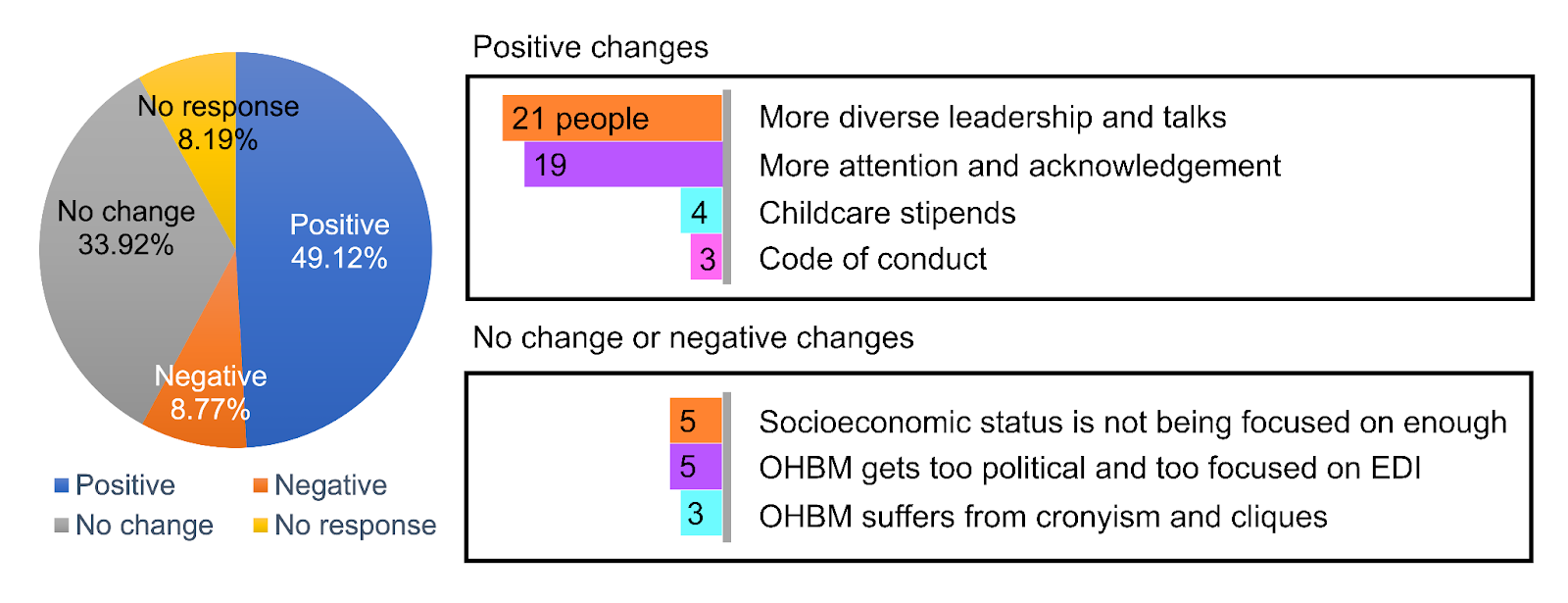|
Presented on behalf of the OHBM Diversity and Inclusivity Committee The OHBM Diversity and Inclusivity Committee (DIC) strives to engage in open dialogue with the community in order to better serve its diverse membership. We are committed to continually educating ourselves regarding issues that impact all members, with a focus on ensuring an inclusive experience for everyone at OHBM sponsored activities. In January 2021, the DIC collected feedback from the OHBM membership in a survey entitled: “Survey of Member Views on Inclusivity at OHBM”. This survey was designed to collect quantitative metrics and qualitative responses regarding feelings of “belongingness” in our membership. Free response questions were included to identify areas of concern for OHBM to work on improving. Finally, the survey also collected demographics and other identification characteristics of our membership. Here we present a summary of survey responses and provide suggestions for addressing the concerns raised. This is an ongoing conversation – please leave comments below. Summary of survey respondents’ demographics We received 171 responses from individuals who reside in 25 unique countries (Fig. 1a). Of those who reported gender identity, 60 (35%) of respondents identified as female, 51 (30%) as male and 1 (<1%) responded as non-binary (Fig. 1b; 59 (34%) respondents did not report gender). Mid-career researchers participated in the survey more than people in other career stages (Fig. 1c). While 46% of respondents reported White/European identity (Fig. 1e), 24% identified themselves as a member of an ethnic/racial minority group (Fig. 1d).  Figure 1: Demographic information of survey respondents. The countries in which respondents resided at the time of the survey (a), their gender identity (b), their career stage (c), whether they identified as a member of an ethnic/racial minority group (d), and their ethnic/racial identities (e) were reported. Reported experiences of belonging and discrimination at OHBM “Feeling of belonging” was rated similarly by respondents who identified themselves as an underrepresented minority (n=21) as those who identified as from a non-minority group (n=78). (Fig. 2a left and right). At least twelve colleagues shared stories of active discrimination during OHBM activities, including socioeconomic background, language, political opinions, country of origin, gender, religion, ethnicity and neural disorder. Two respondents voiced feeling discriminated against by the survey itself, arguing that OHBM is taking a “too-woke” approach. 104 responders thought that there are certain minority groups that are underrepresented at OHBM and that OHBM is dominated by North American and European members.  Figure 2. Ratings of sense of belonging at OHBM from respondents who identified as a non-minority (n=78; median = 8, IQR = 3;left) and from those who identified as an underrepresented minority (n=21; median = 7, IQR = 2.5; right). Responses from those who did not allow OHBM to link their demographic data to their responses are not shown. Focus on language barriers and English fluency OHBM is an international society with members from over 72 countries across the globe. A previous blog post highlighted the unique challenges that members for whom English is a second language face when deciding on whether to engage in oral presentations at the annual meeting. Our survey included 8 responders indicating that language barriers make some members reluctant to select the “talk preferred” option during abstract submission. Additionally, some respondents speculated that discrimination against Asian speakers might go beyond language barriers (given that individuals from Commonwealth countries often speak excellent English), and that the lack of inclusion of these indiviuals at OHBM may be related to race or their country of origin. Feedback from the OHBM members regarding Equity, Diversity, and Inclusivity (EDI) From the survey, 59 respondents suggested areas to improve inclusion and promote diversity at OHBM. Some of these suggestions are summarized below:
Summary of positive and negative changes reported in the survey We observed a range of viewpoints regarding whether OHBM is making positive or negative changes towards promoting diversity and inclusion (Fig. 3). The survey showed that 84 (49%) respondents felt that the OHBM is exhibiting positive changes in promoting Equity, Diversity and Inclusion (EDI). Many felt that more women and people from underrepresented groups took leadership roles and were selected as speakers at the 2020 meeting than previous meetings. Others felt that our community now pays more attention to EDI and acknowledges EDI issues. The creation of child care stipends and the OHBM code of conduct were also considered as positive changes.
In contrast, 15 respondents (9%) voiced negative changes they have noticed in the survey (Fig. 3). In line with the financial barrier to attend the meeting, some respondents felt that OHBM needs to make progress in supporting individuals of low socioeconomic status. Meanwhile, others expressed concerns that OHBM suffers from cronyism and cliques, and that they felt only certain nations or groups are dominating the scientific atmosphere at OHBM.
Some respondents (n=8) felt the Code of Conduct is too vague and others (n=3) expressed worry that it can be too easily misinterpreted. One respondent suggested that more precise definitions of untolerated behavior should be provided. With respect to enforcement of Code of Conduct violations, another respondent suggested that an informal solution (e.g., speaking to an offending person directly) is preferable before resorting to a formal complaint to the organization. Survey limitations We note several limitations of the survey, suggesting careful interpretation of the results is needed. First, the median sense of belonging between the self-identified minority and non-minority groups were similar (7 and 8, respectively). However, because the participation rate from under-represented groups in our survey was very low, this may in and of itself reflect low sense of belonging or low expectation of voices being heard. Therefore, we will investigate how we can increase future participation from these groups in subsequent surveys. Next, the survey focused on scientific and formal components such as talks, without considering the impact of language and cultural barriers on networking and social events. Lastly, we will need to further discuss future directions of OHBM DIC considering the reported negative perspectives such as over-emphasis of EDI. Suggested future directions from the Diversity and Inclusivity Committee Based on these findings, as a committee we suggest that OHBM leadership considers the following in organizing future events:
Concluding remarks OHBM is a scientific community and embracing diversity and fostering inclusion is at the core of scientific practice. It is our responsibility to advocate for inclusivity and diversity at OHBM, as diversity brings creativity and inclusion brings trust and commitment to our organization, and the scientific process more generally. These results highlighted the recognition of positive changes in our organization but also some weak areas (including geographic and minority group engagement) which we seek to improve. We welcome your reactions and feedback in the comments below. Survey was designed by Diversity and Inclusivity Committee members: AmanPreet Badhwar, Valentina Borghesani, Davynn Tan, Lee Jollans, Laura Marzetti, Sharlene Newman, Rosanna Olsen, Pradeep Raamana, Tilak Ratnanather, Athina Tzovara, and Lucina Uddin.
Survey was analyzed by a Data Collection Sub-committee: Julio Alejandro Yanes, Melvin Atay, Valentina Borghesani, Lee Jollans, Kangjoo Lee, Laura Marzetti, Rosanna Olsen, and Pradeep Raamana). Preliminary results analyzed by this group were presented during the OHBM 2021 DIC Roundtable. Blog post written by AmanPreet Badhwar, Valentina Borghesani, Julia Kam, Kangjoo Lee, Rosanna Olsen, Pradeep Raamana, Lucina Uddin, and Maryam Ziaei
0 Comments
Your comment will be posted after it is approved.
Leave a Reply. |
BLOG HOME
Archives
January 2024
|

 RSS Feed
RSS Feed